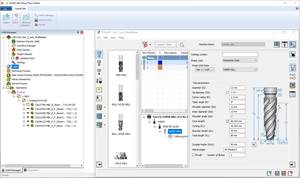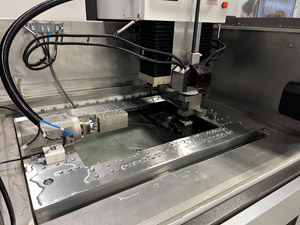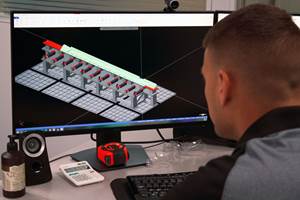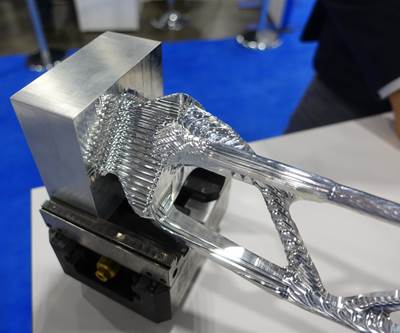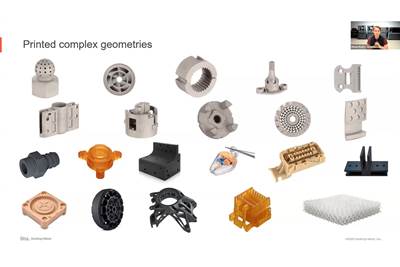Generative Design for Milling Lightweights EV Motorbike Part
Autodesk’s Fusion 360 generative design function can create mass-saving solutions for three-axis milling and other conventional manufacturing processes.
Share






Hwacheon Machinery America, Inc.
Featured Content
View More.png;maxWidth=45)
DMG MORI - Cincinnati
Featured Content
View More

The three-piece milled swing arm Autodesk created through generative design saves 8% of mass compared to the original die-cast part. Lightning Motors says the revised swing arm should increase the performance capabilities and rider feel of its LS-218 motorcycle on account of the part’s reduced weight and enhanced directional stiffness. All images courtesy of Autodesk.
Generative design is an efficient way to remove mass from a part design, but manufacturing the generated part can still be expensive, particularly for metal parts. Lightning Motorcycles, a California-based manufacturer of electric motorcycles, knows this especially well.
In 2018, Lightning partnered with Autodesk to lightweight a production motorcycle swing arm through generative design. The resulting plan created a magnesium alloy part that was 38% lighter, but which required Lightning to use investment casting and increased costs beyond commercial feasibility.
In 2021, the companies repeated the generative process with an updated solver in Autodesk’s Fusion 360 CAD software. This new solver supports a wider variety of manufacturing methods, including three-axis milling. Specifying milling as the final production method resulted in a three-part prototype build that met performance needs while saving 8% of mass at a much smaller price increase. The new generated part also helps maintain supply chain continuity by using the same 6,000-series aluminum as the original die cast part.
What Is Generative Design?
Generative design software uses a set of user-input parameters and constraints to develop efficient part designs. These shapes are often organic forms no human would design on their own, and in its earliest years generative design was locked to additive manufacturing and production methods facilitated by additive manufacturing. Not long after Lightning and Autodesk developed their first iteration of the generatively designed motorcycle swing arm, Autodesk updated its solver to support milling and other conventional manufacturing methods. Design candidates generated for milling generally cannot reach the same level of optimization as their AM siblings, but they are much easier to manufacture while still reducing the weight of the part.
The generative design system produces a wide variety of potential solutions, even within a traditional manufacturing method like three-axis milling, so it also includes a filtering system to focus on top-performing solutions for the user’s performance criteria. Users can manually adjust designs in a manner Simpson describes as like sculpting clay: dragging a point out of the design moves the surrounding area to merge it into a smooth shape.
Problems and Parameters
Autodesk Fusion 360 technical consultant (and designer for the project) Peter Simpson says the generative design process begins with defining the “problem.” Part of this definition involves choosing the final production method. The software also asks users to set several method-specific parameters to further narrow down results: one example for three-axis milling would be the user’s minimum tool diameter.
After setting the production method and parameters, Simpson imported Lightning’s CAD file of the original, die-cast part into Fusion while Autodesk principal research engineer Nick Markovic examined Lightning’s finite element analysis (FEA) report for the part. Both the CAD file and the FEA report focused on the full assembly rather than the individual parts, so Simpson and Markovic separated these out — but not before Simpson used the full model to highlight pieces of present geometry, such as interfaces and bolt holes, that future designs needed to keep, as well as obstacles like motorcycle wheel these designs needed to avoid. Fusion 360’s shared, cloud-based file system enabled the pair to conduct their work simultaneously without causing errors.
While the 2021 milled part (top) does not reduce the original part’s weight to the same extent as the 2018 investment cast version (bottom), the newer part has proved less expensive and outperforms the 2018 version in structural and load requirements. Click to expand the image.
Narrowing the Possibilities
The generative design system produces a wide variety of potential solutions, even within a traditional manufacturing method like three-axis milling, so it also includes a filtering system to focus on top-performing solutions for the user’s performance criteria. Users can manually adjust designs in a manner Simpson describes as like sculpting clay: dragging a point out of the design moves the surrounding area to merge it into a smooth shape. Simpson also says users can leverage accessibility check or minimum feature analysis functions to see which adjusted features would be incompatible with the chosen manufacturing method, but this check is not automatic.
After narrowing the field of design candidates, Markovic used a separate workspace within Fusion 360 to perform stress and load simulations. According to an Autodesk University presentation from Simpson, Markovic and Lightning Motorcycles president Richard Hatfield, these stress analyses of load cases examined the part’s maximum deflections and surface stress to determine its “Factor of Safety,” or whether the stresses were above the material’ strength limits. The 2018 design failed to meet today’s Factory of Safety requirements, but Markovic and Simpson were able to tailor their 2021 three-axis design candidates until one passed this test.
Proving-Out
After finding a prototype design that met Lightning’s requirements, Simpson and Markovic began proving it out at Autodesk’s Birmingham Technology Center. Their feasibility studies focused on determining what kinds of jigs and fixtures Lightning would need to produce these parts through CNC milling.
At the conclusion of the feasibility studies, Autodesk will hand off the prototype to Lightning Motorcycles to enable Lightning to make tweaks for commercial production viability.
Related Content
Building A Powerful Bridge from the CAM Programmer to the Shop Floor Operator
SolidCAM for Operators provides a powerful bridge from CAM programming to the shop floor to best streamline the machine shop process with its CAM part simulation. It provides a clear picture to the operator for setup and prove-out, enables minor G-Code changes and avoids crashes, broken tools and scrapped parts.
Read MoreOrthopedic Event Discusses Manufacturing Strategies
At the seminar, representatives from multiple companies discussed strategies for making orthopedic devices accurately and efficiently.
Read MoreHybrid Control Makes Lights-Out EDM More Accessible
This CNC enables EDMs to switch between G-code and an integrated CAM system to adapt to changing conditions and make lights-out manufacturing more attainable.
Read MoreLarge-Format Machining With Small Cutting Tools and Dynamic Motion
Napoleon Machine, a defense contractor that provides parts for the M1 Abrams tank, recently took advantage of a CAM feature that allowed the company to streamline its cutting strategies and program offline. Here’s how the shop cut cycle times nearly in half with its large-format five-axis machining operations.
Read MoreRead Next
Generative Design Generates New Interest in a Range of Manufacturing Options
New developments in generative design can help companies make better decisions about part design by including manufacturability as a key value. CNC milling, for example, not an additive process, might come up as the better choice for making a complex part.
Read More3D Printing, Generative Design Put This EV on a "Diet"
Redesigning and consolidating the components of Arcimoto's Fun Utility Vehicle (FUV) will bring this small electric car into the realm of micromobility. More in a recent episode of The Cool Parts Show.
Read MoreMethods and Benefits of Designing for Additive Manufacturing
Additive manufacturing may have different process considerations than traditional manufacturing, but it can manage these through clever planning and specialized software.
Read More


























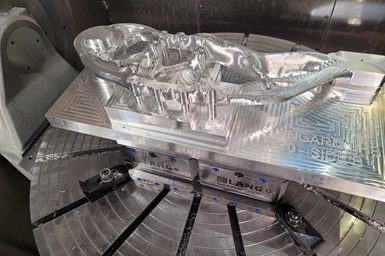



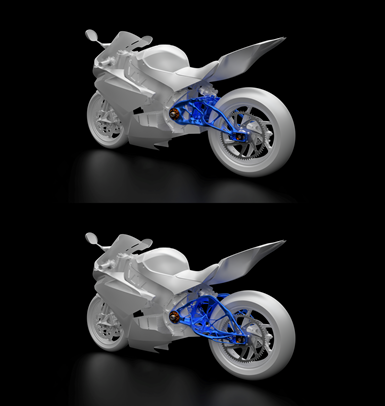





.jpg;maxWidth=300;quality=90)


